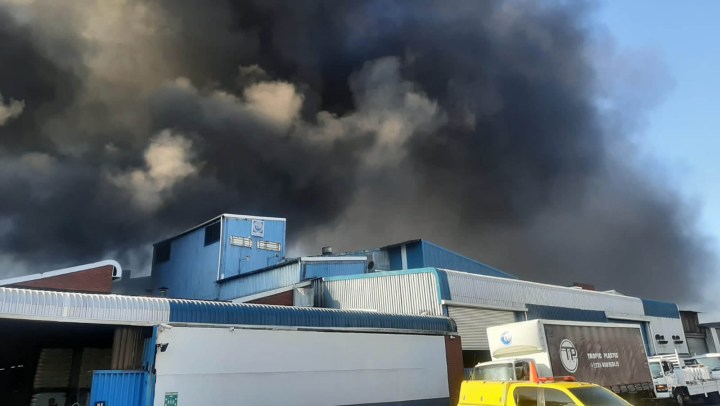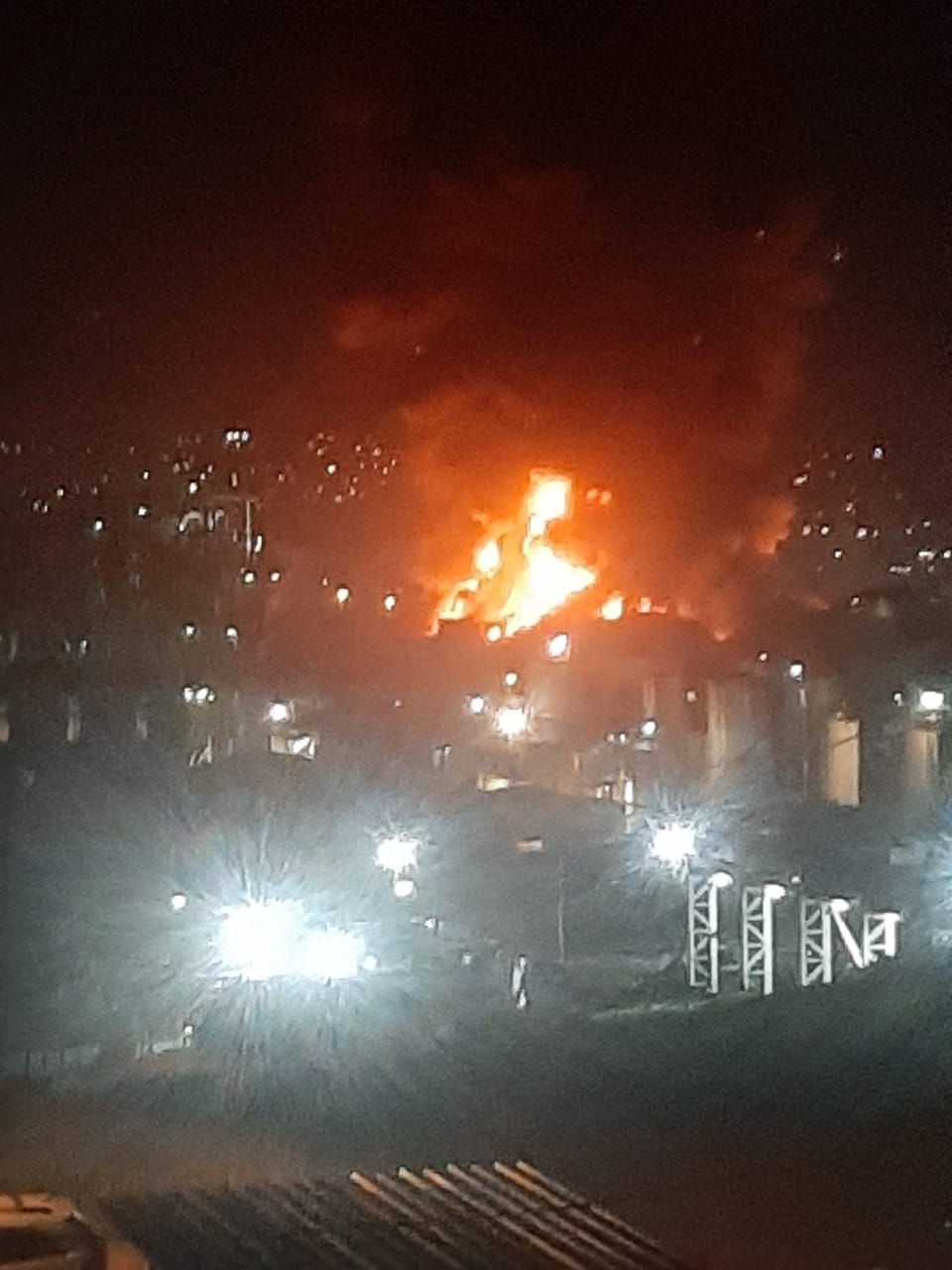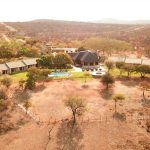OUR BURNING PLANET
Here we go again: Durban residents warned to stay indoors after second toxic chemical fire

Barely a month after the massive UPL pesticides warehouse explosion in Durban, another chemical factory fire broke out south of the city on 25 August, releasing a cloud of poisonous fumes that sparked an official public health warning by the Ethekwini Municipality. The temperature of the fire under the feet of government regulators has just risen another notch as they scramble to douse growing public anxiety around chemical safety management in the city.
Correction: In an earlier version of this story it was incorrectly reported that the fire at KZN Resins had spread to a plastics company next door. Although a boundary wall between the adjoining companies was damaged during the blaze, the fire department said the fire was contained before it could spread into the plastics company.
For the second time in as many months, thousands of Durban residents were warned to take shelter indoors and shut their windows because of dense clouds of toxic chemical fumes — this time from a fire and explosion that broke out in a chemical resins factory.
The fire started at the KZN Resins factory in Balfour Road, Jacobs, in the early hours of 25 August.
According to Durban environmental justice activist Desmond D’Sa, who lives nearby and who drove to the plant just after the fire began, staff at the KZN Resins facility said that they were on night shift when the fire began.
D’Sa, coordinator of the South Durban Community Environmental Alliance, said residents were woken by loud rumblings just before a ball of fire and dense smoke clouds were seen above the plant, which manufactures a variety of synthetic resins such as hydroxy, acrylamide and thermoplastic resins.
D’Sa said the fire burnt for at least five hours before eight fire engines brought the visible flames under control. Just before 3pm, the Ethekwini Municipality broadcast a public health warning urging nearby residents to stay indoors as the plant was still smouldering and releasing toxic smoke.

Durban environmental justice activist Desmond D’Sa said residents were woken by loud rumblings just before a ball of fire and dense smoke clouds were seen above the plant, which is located behind the plastics factory in the foreground (Photo: Supplied)
“Areas affected include Wentworth and Merebank, but due to a change in wind directions, areas such as Clairwood, Montclair, Bluff and Mobeni may also be affected.
“As a precautionary measure, residents are advised to close their windows and doors and to put wet cloths over ventilators until the smoke clears. Residents are further advised to refrain from outdoor activities from impacted areas. Officials will be on site until the situation is resolved. The public will be informed in the event of new developments.”
However, said D’sa, he saw no visible signs of city emergency officials physically warning residents of surrounding areas to stay indoors or to close windows.

Flames rise from the KZN Resins factory in Jacobs, south Durban in the early hours of 25 August. (Photo: Supplied)
Nor did city officials appear to have the capacity to collect samples of toxic fume levels, prompting his alliance to take their own “bucket samples”, a rudimentary method developed in the United States by community activists exposed to frequent chemical releases from nearby petrochemical operations.
He said the fire brigade had also used large volumes of high-pressure water to douse the fire and it remained to be seen whether any waterborne overflow of chemical poisons would soon enter Durban harbour to kill fish and marine organisms in one of the country’s largest estuarine fish nurseries via the Amanzimnyama Canal and stormwater drains.
The latest chemical fire explosion comes as government regulators battle to allay widespread public anxiety around the aftermath of the arson attack on the 14,000m2 United Phosphorus Limited (UPL) pesticides and agrochemicals warehouse in Cornubia, north of Durban.
Earlier this week, following an oversight inspection at the UPL warehouse by the National Assembly’s committee on environmental affairs, the committee compiled a scathing report urging government departments to establish a multi-stakeholder forum to ensure that the public was kept properly informed about the public health and environmental implications of the UPL chemical inferno that lasted for 11 days.
In a report adopted on 24 August, the committee said it had received complaints from community groups that there had been a lack of communication from both the government and UPL.
Concerns were also raised over the exclusion of the representatives of communities and NGOs from the government Joint Operations Committee “even though they represent the very people who bore the brunt of the events”.
“UPL had not made any visible efforts to show empathy for its employees and surrounding communities, with the human health impact of the events not assessed nor communicated. The representatives believed that the latter would have a devastating effect on the lives of communities in the long term. A medical team should have been put together from the beginning to attend to the impact of the incident on human life and mitigate other risks”, the committee reported.
The report included that:
- There were further concerns that there was general secrecy by the company (UPL), on the actual contents of the chemicals that were stored in the Cornubia warehouse;
- There should be adequate compensation by the company for all people who will be found to have been adversely affected by the incident;
- There was a plea that Parliament ensures that all the outstanding and pending investigation reports by the various authorities on the matter be shared with all, including community representatives and NGOs;
- The committee also heard of the devastating impact the incident had left on the tourism sector in the surrounding areas;
- Residents from around the warehouse reported respiratory distress that they suffered on the days of the smoke, some of whom are worried about long-term effects that are yet to be discovered. The children could be the worst affected because they were playing outside while the fires were raging;
- The eThekwini officials assigned to the pollution line ignore phone calls. When they do take calls, they are rude, unhelpful and refuse to issue call reference numbers;
- The community was also worried that the sugarcane growers had continued harvesting the contaminated sugarcane for processing.
“Following the interactions with the stakeholders, the committee makes the following findings and observations:
- The committee was not satisfied that a proper environmental and risk assessment process was undertaken before the company began its operations in the area of the incident, as is legally prescribed by the National Environmental Management Act, Hazardous Substance Act and the Occupational Health and Safety Act, among others;
- The incident revealed a lack of adequate regulation of the industry, which would go a long way in ensuring the curbing of incidents of this kind with regard to the locations of chemical storage facilities;
- The committee was concerned by what seemed a lack of capacity in human, financial and other resources for the involved government authorities to oversee and facilitate the implementation of appropriate remedial actions following the Cornubia incident;
- It was also of grave concern that the eThekwini Fire Department could not respond on time to begin with the extinguishing of the fire, and nor could they receive the necessary support from the South African Police Service and the South African National Defence Force to undertake that crucial task on time;
- The committee further noted with dismay that the plans by UPL were more concerned with the clean-up and reinstating operations, to the detriment of proper assessments and interventions on the impact to human health;
- The committee was also concerned that government had not required more urgent work to be undertaken in relation to understanding and communicating the impacts on human health, particularly resulting from the air pollution;
- The committee heard from the Department of Labour’s health and safety specialist that the company had not complied with the legal requirements related to notification, risk assessment and approved emergency plans as per the Major Hazard Installations Regulations (No. R. 692 of 2001) that are supposed to be in place before operations of UPL’s kind can operate;
- It was equally concerning that the company did not yet have the required permit from the eThekwini Municipality to store hazardous chemicals in the area;
- At the time of the visit, both UPL and the Environmental Department were yet to release the list of the chemicals and their Material Safety data sheet;
- The committee observed that there had not been adequate consultation and inclusion of the affected communities or its representatives, leading to strained relations between the parties;
- The committee also noted the apparent chemical smell in the area and was worried about the exposure of school children;
- There was an urgent need for UPL to declare the public liability funds set aside for disasters of this calibre, to assist affected communities recover from the traumas associated with the incident or there be a mechanism for compensation.”
The committee further recommended that:
- The national, provincial departments, as well as the eThekwini Municipality, furnish the committee with a report on the company’s standing in relation to legislative and regulatory compliance at various levels as overseen by each of these authorities. This is especially urgent in light of the submission of noncompliance by the health and safety inspectorate at the Department of Labour;
- All departments, as well as UPL, must furnish the committee with all assessments and investigation reports by no later than 30 September 2021;
- That a multi-stakeholder forum be set up that can work alongside the Joint Operations Committee to ensure the inclusion of all the relevant stakeholders, including the community representatives, academia, researchers in the health fraternity and the NGOs;
- The committee received responses from UPL at the time of consideration of this Oversight Report and undertakes to engage the contents of the submission in due course;
- The eThekwini Municipality and the Department of Health should furnish the committee with a thorough report of complaints and occupational health assessment from the communities, including the number of complaints, their status, completion and continuous monitoring;
- The Department of Health and the Department of Agriculture, Land Reform and Rural Development should conduct an analysis and legislative review of the Hazardous Substances Act 15 of 1973 as well as the Fertilisers, Farm Feeds, Agricultural Remedies and Stock Remedies Act 36 of 1947 to identify gaps and areas that need urgent updating;
- The department must submit the report on the conducted EIA and exemptions in the special economic zone where the UPL warehouse is located; and
- The eThekwini Municipality with support from the specialists in the Department should submit a plan on how the team plans to handle the waste and settled chemicals in and around people’s homes and including continuous monitoring. DM/OBP




















 Become an Insider
Become an Insider
Surely a prosecution of UPL must follow when there appears to be such blatant disregard of environmental laws?!
Yet another example of political patronage, complete disregard for common citizens and a greedy determination to divert culpability. A US$1 billion fine would help greatly?
On 1? US$ 20 billion more like.
Do Laws of Compliance for Chemical plants vary among countries?
I see that the names Dawood and Moosa are registered on compliance certificates for KZN Resins. Are these local Indians or representatives of an Indian owned company? I’m not sure why Chemical Companies with Indian connection appear to be so lax in operating safely? Are safety laws in India not as stringent as International laws? Very confusing. I wonder what the Insurance Companies providing cover for SA Chemical operations have to say about the level of compliance required here.
Jane, this sounds like the old story of cutting costs and thereby cutting down on safety and maintenance. It’s tragic that decisions that could threaten human health and the environment are taken so lightly but if the punishment doesn’t fit the crime then the practice will continue.
Two words: Class Action.
Another two words: Lots. and Lots.
No deadline on these documents